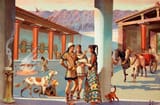Search Results
7/8/2025, 4:25:01 PM
>>17825201
>The remaining (non steppe-related) Mycenaean ancestry was similar to that of the Minoans and the Early Bronze Age population of mainland Greece, and elite Mycenaean samples (from the Palace of Nestor at Pylos and its environs) did not differ from the general population in terms of their average ancestral composition
>According to Lazaridis et al. these results strongly support the hypothesis that Mycenaeans were the outcome of admixture between descendants of Yamnaya-like steppe migrants and a Minoan-like population, with steppe migrants considered to be Indo-European speakers and progenitors of the Greek language. Minoans were predominantly of Early European Farmer ancestry (74±3% on average), with additional Caucasus Hunter-Gatherer ancestry (18.2±1.2% on average). Lazaridis et al. also identified Levant Pre-Pottery Neolithic ancestry in some Minoan and Mycenaean individuals
>In a comment on the study by Lazaridis et al. (2022), Paul Heggarty of the Max Planck Institute expressed doubts regarding the connection between the "small contribution in Mycenaean Greece" of the "ancestral mix of Yamnaya culture" and the steppe as the "earliest, original source" of Indo-European languages
>A study by Skourtanioti et al. (2023) generated genome-wide data from 95 Bronze Age individuals from mainland Greece and the Aegean, which was analysed in the context of all previously published samples from the region. Mycenaean (Late Bronze Age) individuals were found to deviate from Early Bronze Age individuals in the direction of Central and Eastern European Bronze Age populations, due to having western steppe-related ancestry not found in the earlier samples
>The remaining (non steppe-related) Mycenaean ancestry was similar to that of the Minoans and the Early Bronze Age population of mainland Greece, and elite Mycenaean samples (from the Palace of Nestor at Pylos and its environs) did not differ from the general population in terms of their average ancestral composition
>According to Lazaridis et al. these results strongly support the hypothesis that Mycenaeans were the outcome of admixture between descendants of Yamnaya-like steppe migrants and a Minoan-like population, with steppe migrants considered to be Indo-European speakers and progenitors of the Greek language. Minoans were predominantly of Early European Farmer ancestry (74±3% on average), with additional Caucasus Hunter-Gatherer ancestry (18.2±1.2% on average). Lazaridis et al. also identified Levant Pre-Pottery Neolithic ancestry in some Minoan and Mycenaean individuals
>In a comment on the study by Lazaridis et al. (2022), Paul Heggarty of the Max Planck Institute expressed doubts regarding the connection between the "small contribution in Mycenaean Greece" of the "ancestral mix of Yamnaya culture" and the steppe as the "earliest, original source" of Indo-European languages
>A study by Skourtanioti et al. (2023) generated genome-wide data from 95 Bronze Age individuals from mainland Greece and the Aegean, which was analysed in the context of all previously published samples from the region. Mycenaean (Late Bronze Age) individuals were found to deviate from Early Bronze Age individuals in the direction of Central and Eastern European Bronze Age populations, due to having western steppe-related ancestry not found in the earlier samples
Page 1
